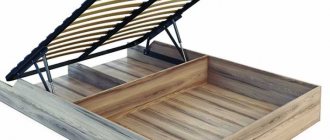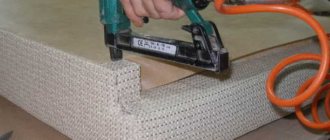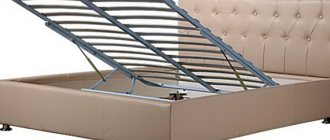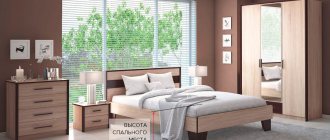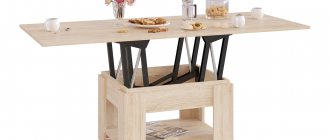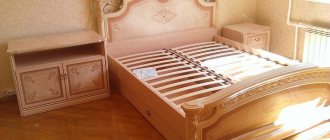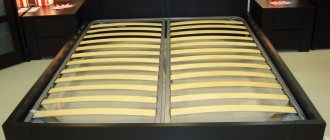How to choose a bed base?
The base is one of the main parts of the sleeping place, what the mattress rests on.
It is attached to the bed frame or used as an independent sleeping place if it has legs. A high-quality base enhances the orthopedic properties of the mattress and provides a person with a healthy and comfortable sleep. Bases vary in type, design, and material. To make the right choice, “O, mattresses!” invites you to familiarize yourself with the features of modern foundation models.
Size
The dimensions of the bases correspond to the standard sizes of single, single and double beds (from 60x120 to 200x220 cm). On our website you can purchase bases for non-standard beds, made to order.
Solid. This type of base is gradually losing its popularity, but is sometimes acquired by people with spinal problems, who are recommended to sleep on flat and hard surfaces. The solid base consists of boards, plywood or chipboard sheets. Orthopedic mattresses on a solid base lose their useful properties and are poorly ventilated, due to which they wear out faster. The main advantage of these models is their low cost.
Orthopedic. Due to flexibility and elasticity, they allow mattresses to fully demonstrate their orthopedic properties. They consist of lamellas (slats) attached to the frame using special fasteners - lath holders. Lat holders are mortise and overhead, made of rubber and plastic. The slats provide air and heat exchange in the mattress, which guarantees a healthy microclimate of the product and extends its service life. The recommended minimum number of slats per bed is 15 pieces.
Slat width
Different models of orthopedic bases have different numbers of lamellas, and their width also varies. The closer the slats are to each other, the stronger the base and the more weight a person can withstand. The distance between the lamellas should not be greater than the width of the lamella in this base.
Narrow (3-4 cm). They are considered the most orthopedic option. Bases with narrow slats are suitable for springless mattress models and especially mattresses with an independent spring block with a large number of springs per bed. For heavier people, bases with small-width slats made of durable beech or oak are recommended.
Wide (5-9 cm). Mattresses with an independent spring block with a large number of springs per bed are not suitable, since the springs can fall between the base slats. In other cases, suitable for any mattress model. Bases with wide slats made of birch or pine are designed for lighter loads.
Design
1. Collapsible bases.
A convenient option for transportation to the country, when disassembled it easily fits into a car. It consists of lamellas (slats), a frame, lath holders and legs (if any), which are assembled in accordance with the instructions. The orthopedic properties of such bases are not lost.
2. One-piece design.
The one-piece bases require no assembly and are ready to use. Suitable for home. They can be either solid or orthopedic type, made of metal or wood.
3. Lifting.
Such models are equipped with a lifting mechanism that allows you to raise the base and provide access to the drawers under the mattress, where bedding, toys and other things are stored. This is convenient in small bedrooms as it saves space. Lifting mechanisms can be manual, gas, or spring.
4. Frameless (liners).
Orthopedic bases made of lamellas without supports (legs) and without lath holders, are not attached to the frame. The slats are fastened together with tape and are inserted into the bed frames. Mobile and do not require assembly.
Easy adjustment of wardrobe doors with your own hands: instructions
Lamellas made on professional equipment, also called latoflexes, are wooden planks with a certain level of elasticity. Moreover, they are made from not just plywood, but from bent-glued material. But when made independently, they are usually assembled from wood. The thickness of the factory slats is usually 8 mm. In this case, the width can vary from 30 to 68 mm. The curved shape provides additional useful properties and also helps to increase the strength of the entire structure.
Latoflexes are installed across the base of the bed, be it single or double. The distance between the slats is from 20 to 60 mm. However, it should not exceed the width of one lamella.
To assemble a good single bed, experts recommend using at least 15 slats. If you need a bed for 2 people, then the specified quantity is multiplied by 2.
The higher the weight of the users, the more slats with a smaller distance between them should be used.
For double berths, a middle support bar is used, which connects two parts of the base of the berth. This is about the question of how to insert the necessary latoflexes into a double bed.
In this case, the installation of the lamellas themselves is carried out in 2 rows. In fact, here we are talking about 2 identical orthopedic beds, but combined within one frame. The slats, like the frame, can be made from ash, birch, beech, maple, oak and other trees. Pine is considered the least durable. If you want to make latoflexes with your own hands, you can take boards of suitable sizes, cut them yourself, or order cutting from specialized specialists.
Now about what they can be and how to make and install them with your own hands.
Although we have already actually dealt with the manufacturing issue.
Why do you need an anatomical bed base?
Firstly, it increases the effectiveness of an anatomical mattress. With this configuration of the berth, you are guaranteed comfort and complete muscle relaxation.
Secondly, the anatomical base extends the life of the mattress. A rigid base for a bed, for example, made of chipboard, accelerates the deformation of the product, which should sag slightly under the weight of the human body, but when laid on a hard substrate, it only crumples in places of heavy load. With a special base, deformation will not occur.
What is the base for an anatomical mattress?
The most popular among lovers of healthy relaxation and sound sleep are structures consisting of special transverse slats attached to frame slats. The slats for anatomical mattresses and anatomical models are made of wood, mainly birch, walnut or beech. Birch slats are the most economical option, coping with the assigned tasks no worse than others.
Models may differ in the height of the legs, the width and number of slats, methods of attachment to the frame, the characteristics of the material from which the frame structure is made, and the ability to adjust the rigidity at home.
Step-by-step furniture assembly
Having become familiar with the design features of the transforming bed, you can begin the step-by-step assembly of the structure with a lifting mechanism in the following sequence:
As you can understand, the process of installing furniture with a lifting mechanism is not so complicated if home craftsmen follow the instructions and advice during the work. And video instructions on the Internet resource, conducted by real professionals in their field, will help you solve any difficulty.
A bed with a lifting mechanism is the best option for small apartments, which allows you to solve several problems related to the improvement of the room. Practicality, reliability and versatility are its main advantages. It can act not only as a sleeping place, but also serve as a chest of drawers for storing various things and accessories. Making a bed with a lifting mechanism with your own hands is not as difficult as it might seem at first glance. If all the requirements and recommendations of specialists are met, the bed will turn out no worse than the factory one. In order to figure out how to do this, it is necessary to divide the entire process into several stages, each of which requires special attention.
Dimensions and other features
The minimum length of the grille should be 20 cm greater than the height of the person for whom it is purchased. This recommendation must be taken into account when selecting a design. The width, comfortable for one person of average build, is 80 cm.
The optimal width of the lamellas is 6-7 cm, thickness - 6-8 mm. The number of slats should be such that the distance between them is no more than 8 cm. Why such strict requirements for the size of the slats? Slats located too sparsely provoke the appearance of bumps and hernias on the mattress, as it is pressed under the weight of the body.
The most comfortable leg height is 24-27 cm.
Be sure to buy a model in the size corresponding to the mattress, i.e. having the same length and width.
Selecting a base
In order for the base to be a good match for the mattress, serve for a long time and increase its service life, it is necessary to select a product that is suitable in size and corresponds to the characteristics of the sleeping place.
When purchasing in a store, be sure to check:
- lamellas for the absence of knots, cracks and raw edges;
- frame (there should be no traces of rust on the metal or mechanical damage);
- accessories (its configuration and quality).
It would be a good idea to check for the absence of squeaks; to do this, you need to press on the anatomical slats, rock the legs and frame.
When inspecting the base of the beds, special attention should be paid to the lath holders - they come in rubber and plastic. The rubber fasteners are elastic, so they do not cause rattles after prolonged use of the bed, and are also very durable.
It is also worth considering personal preferences and deciding whether additional features, such as a lifting mechanism, are needed if the base is installed in a bed frame. The presence of a lifting mechanism increases the comfort of the berth. In addition, such a bed will save space: you do not need to buy an additional chest of drawers. The drawers under the base can be used to store bedding, linen and other items.
The main goal of HC "Ascona" is to do everything possible to meet the needs of every person for healthy and comfortable sleep.
Be the first to know about all promotions and special offers - subscribe to the newsletter
- About company
- Certificates
- Reviews
- News
- Askona
- Cheap
- Mattress covers
- Production time
- Offer for hotels
- Department contacts
141075, Moscow region, Korolev, st. Gorky, 12a, office 413
Structural assembly diagram
As the included instructions recommend, first assemble the closet into which the raised bed tucks away. Only then does the actual assembly of the bed begin. First, the side and cross boards are laid out, and the support corners, especially the bottom ones, are screwed to them with self-tapping screws. Then the box-shaped frame is screwed together, and you need to clearly check that all the angles are correct, otherwise it may not fit into the cabinet.
Parts of the plywood bottom are placed on the lower support frame and also secured with bolts and nuts through the holes in the corners. Then the top row of support corners and the longitudinal partition of the internal space are attached. After this, the assembly of the lifting mechanism parts begins.
Two movable loops on the upper edge are attached to the transverse plane located at the head of the bed. They allow the extended structure to fit tightly into the retractable cabinet. Spring lifting systems are attached to the side walls of the box frame at the ends 80-90 cm from the headboard. Gas shock absorbers are installed in parallel on the same mounts. It is necessary to carefully ensure that they stand strictly symmetrically, otherwise the entire system will very soon fail due to overload on one of the sides. On the side opposite the headboard, two support legs are attached in the corners. After this, the mattress support frame is bolted to the upper perimeter of the corners, and then the orthopedic spring mattress itself can be laid on top of it.
After this, the build process can be considered complete. With the help of a lifting mechanism, the entire bed, if assembled correctly, should be easily lifted into the closet with one hand. The ascent speed should be fairly smooth. It must be admitted that such beds in furniture showrooms and stores are often unreasonably overpriced, since the demand for them is traditionally high. Making them to order will also be quite expensive, for the same reasons.
So the best option is to make such a bed yourself.
Moreover, making a frame, purchasing a mattress and lifting mechanism parts, as well as all the accompanying accessories, is not a problem.
Many of the residents of apartments in high-rise buildings would like to buy themselves a large bed, which will allow them to spend their holidays in comfort. But at the same time, the area of some bedrooms leaves much to be desired - sometimes it is simply not enough. Very often a situation occurs when a huge bed blocks access to the wardrobe or prevents the door to the balcony from opening, or even the door to the room. In such cases, there seems to be only one rational solution - this is the search and purchase of furniture that would have a special mechanism. The use of such structures would save a lot of space, but, unfortunately, not everyone understands assembling a bed with a lifting mechanism. Let's look at this seemingly complex procedure and pay attention to the main nuances.
